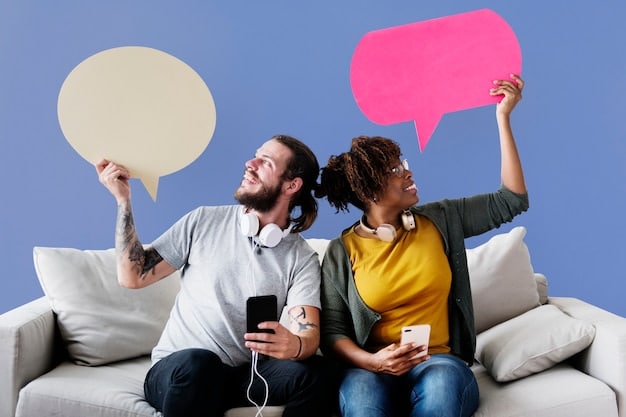Second Lead Syndrome: Why US Viewers Love the Underdog

The Second Lead Syndrome describes US viewers’ empathy for supporting characters in TV shows who are romantically interested in the protagonist but ultimately do not end up with them, often eliciting stronger emotional connections due to their vulnerability and unrequited love.
Do you ever find yourself more invested in the character who *doesn’t* get the girl? You’re not alone. The **Second Lead Syndrome: Why Are US Viewers So Invested in Characters Who Don’t Get the Girl?** is a widespread phenomenon, especially in the US.
Understanding the Second Lead Syndrome
The Second Lead Syndrome isn’t a medical condition, but a cultural phenomenon. It describes the tendency for viewers to sympathize with and even prefer the second lead character in a romantic plot, especially when that character is nice, supportive, and clearly in love with the protagonist, but destined for heartbreak.
This isn’t just a fleeting preference; it’s often a deep emotional investment. Why do US viewers, in particular, fall so hard for these characters? There are several compelling reasons.
The Appeal of Unrequited Love
Unrequited love is a universal theme. It resonates with many people who have experienced the sting of longing for someone who doesn’t reciprocate their feelings. On screen, this translates into empathy for the second lead.
The “Nice Guy” Trope
Often, the second lead is portrayed as the “nice person” – kind, caring, and always there for the protagonist. While the main love interest might be brooding or unavailable, the second lead offers unwavering support and affection. This contrast can be very appealing.

Here are some factors that contribute to the second lead’s popularity:
- Relatability: Second leads are often more relatable than the seemingly “perfect” main characters.
- Vulnerability: Their vulnerability makes them endearing.
- Emotional Investment: Viewers invest emotionally in their happiness, hoping they finally get the love they deserve.
- Moral Alignment: often more sympathetic to viewers expectations for character behavior
Ultimately, the Second Lead Syndrome speaks to our desire for genuine connection and the hope that even the “underdog” can find happiness. We see a bit of ourselves in their struggles, making their stories all the more compelling.
Cultural Context: US Preferences in TV
American television has a long history of romantic storylines, but the specific type of characters viewers tend to favor can vary over time and be culturally influenced. In the context of the Second Lead Syndrome, there are a few US-specific factors that might play a role.
One could be the US cultural emphasis on the “underdog” – the person who overcomes obstacles to achieve success. Viewers are conditioned to root for the underdog, to celebrate those who have to work harder for their victories. The second lead, often overlooked, fits this narrative well. There are a few considerations.
US Emphasis on Individualism
The US values independence and self-reliance. Second leads, especially when they’re denied the protagonist’s love, often exhibit resilience and a determination to find their own path. This resonates with American viewers.
Changing Romantic Ideals
Traditional TV often portrays the main hero as strong and stoic characters, but modern audiences are increasingly drawn to characters who show a lot of emotions and they are sympathetic to the more emotionally forthcoming second lead character.

These points highlight why some cultural attitudes in the US may have a very strong reaction to the idea of the second lead’s sadness:
- Shift in Priorities: The “bad guy” trope is not always the most interesting one, so the second lead is preferred.
- Relatable Problems: Second leads have real problems like jealousy and lonliness.
- The Hope for Love: The US audience is hopeful in nature, so they hope the second lead wins.
The US cultural landscape is constantly evolving, influencing how viewers perceive and engage with romantic storylines and characters on television. The Second Lead Syndrome is a fascinating reflection of these changing preferences.
Analyzing Popular Second Lead Characters
Let’s move beyond theory and look at some specific examples of second lead characters who have captured the hearts of US viewers. Analyzing these characters can provide a deeper understanding of the appeal that drives the Second Lead Syndrome.
Many television shows will often have characters that are great additions to the story, but have the unfortunate fate of being the second lead.
“Dawson’s Creek”: Pacey Witter
While Dawson Leery was positioned as the main love interest for Joey Potter, many viewers found themselves drawn to Pacey Witter’s charm, wit, and genuine affection for Joey. His transformation from class clown to a mature and caring partner resonated with audiences.
“The Vampire Diaries”: Stefan Salvatore
Although Stefan Salvatore was one of the two main characters, he was often seen as bland next to his brother Damon. While he got the girl first, viewers preferred Damon due to his rebellious personality and constant back and forth with Elena.
There are a few common qualities that they possess, and the qualities speak to the audience:
- Kindness: Second leads are usually extremely kind to the female lead.
- Vulnerability: The audience hopes to see them win because they are the underdogs.
- Loyalty: Second leads are almost always extremely loyal.
By analyzing these examples, we can see that the Second Lead Syndrome is driven by a complex interplay of character traits, storylines, and audience expectations. They are the emotional core of many a romance.
The Impact of Social Media on Fandom
Social media has amplified the Second Lead Syndrome, providing a platform for viewers to express their support for these characters, share fan theories, create fan fiction, and even lobby for changes in the storyline. The role of social media has become vital.
Platforms like Twitter, Reddit, and Tumblr is one place where fans can meet to discuss their favourite shows. These platforms allow fans to voice their opinions about the storylines and character arcs, but also engage with one another.
#SecondLeadSyndrome
Hashtags like #SecondLeadSyndrome allow fans to connect with others who share their passion. This creates a sense of community and shared experience. Fans often create edits for the shows, hoping to convince others that the second lead deserves more screen time.
Fan Theories and Speculation
Social media allows fans to dissect every episode, analyze character interactions, and develop theories about where the story will go. The second lead often becomes a focal point for these discussions, with fans passionately arguing for their character’s romantic prospects.
Social Media helps fans achieve these goals:
- Connect with each other: Fans love to share their opinions.
- Create fan edits: Edits can sway public opinion.
- Get more screen time: Fans will petition shows to get more time for certain actors.
Social media has changed the way TV shows are made. The writers see what the fans are saying and they try to pander to those notions in an effort to maintain viewership.
The Business of Heartbreak: TV Show Writers and SLS
TV show writers are well aware of the Second Lead Syndrome and the passionate reactions it can generate. They often use this phenomenon to their advantage, creating storylines that capitalize on viewer sympathy and keep them engaged.
Writers often introduce the “second person” early in a series, and then have them be a staple throughout the show. This is a great way to get the audience invested early on, especially when there’s a love triangle.
Creating Tension and Drama
The presence of a compelling second lead creates tension and drama, adding layers of complexity to the romantic narrative. This keeps viewers guessing and coming back for more.
Fan Service vs. Story Integrity
Writers face the challenge of balancing fan expectations with the needs of the story. Catering too much to the Second Lead Syndrome can feel contrived, while ignoring it can alienate viewers.
The writers often walk a thin line to tell stories they want to tell. When walking that line, writers need to consider these topics:
- Fan Opinion: The more the fans like a character, the more likely they are to be written in for more screen time.
- Emotional Story Arcs: Emotional stories are the most compelling.
- Balancing the Story: The writers have to balance fan expectation with the overall plot.
The Second Lead Syndrome presents both a challenge and an opportunity for TV show writers. By understanding the dynamics of viewer sympathy and carefully crafting their storylines, they can create more engaging stories.
Beyond Romance: The Second Lead’s Value
While the Second Lead Syndrome is often discussed in the context of romance, the value of these characters extends beyond their romantic prospects. Second leads often serve important functions in the overall narrative, providing support, comic relief, or even a moral compass for the protagonist.
It is not enough for second leads to just pine after the female lead, and here’s how to give second leads more character.
Supporting Roles
Second leads often serve as the protagonist’s confidantes, offering advice and support during difficult times. They can be the voice of reason or the shoulder to cry on, enriching the main character’s emotional journey.
Comic Relief
Some second leads are designed to provide comic relief, lightening the mood and offering a contrast to the more serious aspects of the story. This can make them particularly endearing to viewers.
There’s nuance for all the characters, as show writers must be sure to not paint them into a corner. Here’s some key points to ensure the characters have value:
- Give them friends: Shows with supporting characters make them feel more humanized.
- Give them a job: It can be helpful to see what the character does on a day to day basis.
- Give them time: Showing the background of the character helps a lot.
Second leads are much more than that. They may not end up with the leading character, but they can give viewers a better understanding of the purpose of a story and life.
| Key Element | Brief Description |
|---|---|
| 💔 Unrequited Love | The pain of loving someone who doesn’t love you back. |
| 🫂 Audience Connection | The second lead is often more approachable and down to earth. |
| 📱 Social Media | Fans connect with others online. |
| ✨ The “Nice” Trope | The second lead can also be the “nice” character. |
Frequently Asked Questions
▼
The Second Lead Syndrome describes the empathy viewers feel for a the second lead in a romance. The second lead is not the main love interest, but one who often loses the girl.
▼
In the US, having a dream and failing is common. The second lead is often destined to fail, but they fight so hard to achieve what they want that many viewers empathize with them.
▼
Social media like Twitter and Reddit has given fans a voice. Through the use of fan edits and posts, it is simple to connect with others opinions on their favourite tv show.
▼
Absolutely! Writers often deliberately exploit the syndrome by offering the second lead many scenes and character moments. This is often done to see if the fans are invested in the second lead winning.
▼
Yes, a show can recover if a lot of support comes for the second lead. The writer can acknowledge the support, and start giving screen time to those characters. The second lead can then go on to win!
Conclusion
The Second Lead Syndrome is a complex phenomenon reflecting US viewers’ desires for relatability, vulnerability, and underdogs in their TV romances. We hope to continue to see this play through the show.





